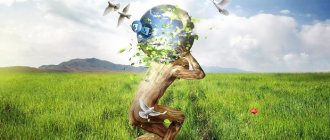You probably know the phrase “Man is a social being.” It is interesting because it very accurately and succinctly describes the dual nature of people. On the one hand, man is a biological being, the same as other animals, and differs from them only in the special organization of mental activity. On the other hand, man is the only animal that is capable of putting social values above biological needs. Let's take a closer look at what is biological in a person, what is social, and consider examples. Let's find out what the differences are between these concepts and what the relationship is between them. Let's start with the biological.
Biological in man
From the point of view of anatomy and physiology, man is the most common biological creature. Each of the systems present in our body solves certain biological problems. For example, the circulatory system provides all organs with oxygen and nutrients, and the lymphatic system ensures their cleansing.
We are completely dependent on the state of these systems, so we must constantly maintain them. We need to sleep, eat, and satisfy other physiological needs. Nevertheless, sometimes we get sick, and then the whole body begins to “fail.” But soon the immune system copes with the disease, and all systems work as usual again. All these processes are purely biological , and occur in us in exactly the same way as in most warm-blooded animals.
Interestingly, many of our systems are inferior in their capabilities to similar animal systems. Our eyesight cannot compare to that of an eagle, we cannot run as fast as a cheetah, and our stomachs cannot digest grass into nutrients the way a cow's stomach can. Nevertheless, in our overall potential we are superior to all animals, and this is ensured precisely by our social nature.
Why should a person work? (6th grade)
Work occupies the most important place in a person’s life. This is the engine of life. For everyone, work is a different category. Those who have found themselves in life can consider work a calling. And those who have not found a profession to their liking are obliged. Labor is both an internal need and a forced necessity. A person must work in order to satisfy his needs, but on the other hand, a person must work in order to become active.
To make work much easier and not be a burden, you need to experience joy from your work. Only in this case will work be a pleasure.
Recognition and reward should also be necessary accompanying work. Recognition is important to history, reward is important to life. People who are not engaged in work may have received a good inheritance, or created their own business that does not require physical labor.
Examples of biological features
Man differs from other animals in many biological features. The most important and clearly visible signs include:
- Developed hands. Humans have very well developed hands, which allows them to be used in a variety of ways. Like other primates, they are very tenacious and quite strong. This allows you to pick up heavy objects and do rough work. But what makes a person unique is his developed fine motor skills, which allow him to also perform very delicate work.
- Upright walking. Many animals can stand on their hind legs or even walk on them. But only for humans, upright walking is the main type of movement.
- Reduced hairline. Since man has been protecting himself from the cold with clothing for many millennia, there is practically no hair left on his body. Interestingly, this trait is not unique, and many marine mammals also do not have hair.
- Developed brain. Humans have the highest encephalization coefficient (a measure of the ratio of brain mass to body mass) of all animals. In an adult of average build it is approximately 7.3-7.8. The second step in this “rating” is occupied by bottlenose dolphins (a genus of dolphins) with an encephalization coefficient of 5.4.
- Speech. The ability to speak clearly, pronouncing complex combinations of sounds, is a unique feature of humans, distinguishing them from all mammals. Interestingly, some birds are able to learn to “speak.” However, the speech of birds has a different nature - they have a well-developed ability to imitate sounds. That is, they do not utter meaningful phrases, but imitate any sounds in general (for example, parrots often imitate other domestic animals).
Teachings of Erich Fromm
Erich Fromm, a German sociologist and philosopher, argued that the type of human activity is determined by his considerations and living conditions, considerations, in turn, are determined by the structure of the personality. According to his teaching, several types of social character can be distinguished.
Receptive (passive or masochistic)
Beliefs: the source of all benefits is external, it is impossible to create anything on your own, the only way to achieve what you want is to resort to outside help.
Characteristics: they try to resort to the help of others, are extremely irresponsible, in case of failures they shift the blame onto someone else, are highly dependent on authority figures in their social circle, and never occupy leading positions.
Social relationships: they want to be loved, but do not want to love themselves, are not proactive, dependent.
Exploitative (sadistic)
Beliefs: the source of all benefits is in the external environment, it is impossible to achieve what you want on your own, you cannot create something yourself, but you can steal and recycle someone else’s.
Characteristics: they achieve what they want through manipulation and cunning, impose their life beliefs on others, do not tolerate dissent, are easy to work with and are very productive in their field of activity.
Social relationships: interested only in those who need to be conquered or “recaptured”, strive to take a leading position, extremely sociable, but often hostile; They evaluate others according to their degree of usefulness, they are cynics, they treat new acquaintances with suspicion, they are envious of the successes of others and are very jealous.
Hoarding (acquisitive, destructive)
Beliefs: it is impossible to create - you need to protect and save what you already have, they strive to get as much as possible and give as little as possible.
Characteristics: their home is their main fortress, which they strive to make as comfortable as possible by placing a huge number of things there, they try to restore order everywhere, they do not like change.
Social relationships: they are always under someone’s control, rarely take initiative, are silent and think a lot, structuring and analyzing thoughts, they are stingy with emotions and do not like conflicts.
Market (conformist)
Beliefs: success depends on the ability to present oneself correctly; everyone, including themselves, is a commodity with which they must compete.
Characteristics: they follow the “demand” and quickly adapt to the latest trends, losing their individuality in the process, often adopting the images that are broadcast by the media, and often sacrifice their self-esteem.
Social relationships: they ask the price of others, strive to make useful acquaintances, do not tolerate criticism and other threats to self-esteem, are often unsure of themselves, rarely experience real feelings - they neither love nor hate, do not become attached to anyone and do not value anyone, easily break up communications.
Perceiver
Beliefs: It is impossible to create on your own, but it is possible to help others create.
Characteristics: dependent on others, lack individuality, often live someone else’s life.
Social relationships: sociable, sincerely happy about the successes of others, talk a lot and laugh loudly, always have a large social circle.
Necrophiliac
Beliefs: they don’t think about creation, life is a tragedy.
Characteristics: extremely destructive, prone to depression, have a flexible psyche, and are often religious fanatics or ardent adherents of radical movements.
Social relationships: dependent on other people, suggestible.
Social (sociophilic)
Beliefs: development is the main task of life; they can either create it independently or help others in this.
Characteristics: mature, harmonious individuals, attentive to details, strive to study the world around them, do not oppose themselves to society, but also do not strive to meet its requirements, are aware of their strengths.
Social relationships: they love people, are patient, strive to surround loved ones with care, in the process of their development they try to involve others in the development.
Social in man
Man is the only representative of the animal world who does not adapt to the environment, but adapts it to himself. It is worth noting that human influence on nature can be both destructive and creative. With his actions, he can disrupt its natural harmony, or he can ennoble the world around him, turning gloomy swamps into blooming gardens.
Moreover, almost any human activity is inextricably linked with society. It is only in our interaction with other members of our species and with the environment that we become human, for only then are we truly different from other animals. Our social essence manifests itself through communication, conscious work, the ability to compromise and the desire to be creative by creating something for others.
Consciousness (6th grade)
What is consciousness? A person relates to the world with knowledge; he not only knows, but also knows how to apply the acquired knowledge. He also continues to learn, learning new information. In other words, consciousness is a person’s attitude to the world, an understanding of what he does, how he lives, what he dreams of. Consciousness allows a person to engage in various activities, communicate with other people, and evaluate others and himself.
Consciousness is a quality characteristic only of humans. That is why only a person can become a person.
Examples of Social Features
As a person grows up, his socialization occurs - he acquires the qualities necessary for life in society. Obviously, this process requires constant interaction with other people, and socialization is impossible outside of society. Immersing himself in public life, communicating with other people, he gains intelligence, builds his vision of the world, forms ideas about morality and ethics, and finds a balance between personal freedom and responsibility.
Basic social characteristics of a person:
- Consciousness. Our consciousness is a reflection of the external world in our thoughts, reactions, feelings and experiences.
- Speech. Oral and written communication are the main ways of exchanging information between people.
- Thinking. The ability not only to perceive, but also to intelligently analyze current events, draw certain conclusions and choose rational decisions is also determined by the social nature of a person.
- Work. The main impetus for the development of human society and all civilization was the emergence of organized labor using all kinds of tools.
- Culture. The presence of culture is the main difference between humans and animals (culture usually means everything that is created by man and not by nature).
- Creation. One of the most important differences between humans and animals is also the desire to create something fundamentally new and unique not just like that, but to be appreciated by other people.
Personality (6th grade, 10th grade)
Personality is a set of human qualities that are acquired by him in the process of living in society, in activity and communication with other people.
A person is an active subject of social relations.
Personality is a system of social qualities of a person, formed on the basis of his integration into the system of social relations.
Personality is a separate individual, characterized by integrity, conscious and volitional manifestations.
What kind of personality a person develops into depends on many factors. The development of personality is influenced primarily by environment, upbringing, and interests. From the very first days, parents begin to nurture the personality in their child. Only some people grow up to be smart, purposeful, kind and sympathetic, while others grow up to be angry, unrestrained, and aggressive. Why is this happening? The whole point is that they taught one child in childhood and showed the correct behavior by example. But the second child was not given any attention at all, so he took an example from his less prosperous peers.
Genetics also plays an important role in the development of personality, which, alas, is very difficult to combat.
Psychologists call personality the pinnacle of all human qualities because only personality has consciousness.
Concepts of biological and social
There are two completely opposite approaches: biologizing and sociologizing. Moreover, each of these concepts has a fairly large number of supporters, as well as arguments in its favor.
- The biologization approach focuses on the fact that most social and psychological characteristics of humans have one or another evolutionary explanation. That is, any complex and highly organized social activity is actually explained by some kind of evolutionary mechanisms. For example, if a person wants to create something that other people will appreciate and praise, this is explained by the fact that many thousands of years ago such behavior increased the person’s authority in his tribe and provided him with more opportunities to safely leave offspring.
- The sociologizing approach is based on the fact that it is social factors that are the root cause of the formation of personality. That is, all our aspirations are not consequences of biological instincts, but are formed in the process of socialization. At the same time, biological factors, of course, influence human behavior, but not in a fundamental way.
Man (6th grade)
Parents are the first environment of a child that influences the development of personality.
Man is a social (social) being. He matures and develops between people, in society. In childhood it is a kindergarten, school, family, and later – adult society. The child’s environment, in which he has to live, play, develop, all this leaves its mark on him, thanks to which his personality is brought up.
He is born a man, but he becomes a person.
Unity of biological and social
The biological in man is not separated from the social. It defines a certain set of basic natural properties dictated by nature. At the same time, in the process of socialization, a person forms his own social component, which does not replace the biological one, but complements it. His social and cultural world is built on the biological foundation of genetic prerequisites, as a result of which a unique personality is formed with his own worldview, values, principles, views and ideas.
The biological and social in a person are in continuous interaction, and this interaction can never be considered complete. The biological functions of the body are influenced by social factors to a much greater extent than in other animals. And yet, a person cannot always control his biological needs with the help of his mind. Moreover, often he does not even realize that now nature is taking over, and the next decision, in fact, is made not by him, but by his animal essence.
Strong personality
Throughout life, a person can find himself in extreme situations, which become a test of how strong his inner core is - individuality and personality. How rooted and part of the “I” are his beliefs, principles, worldview, etc.
Austrian psychiatrists Bruno Bettelheim and Viktor Frankl, who were imprisoned in concentration camps during World War II, wrote that a person’s very life sometimes depends on the preservation of individuality. The conditions of the concentration camps led not only to physical exhaustion, but also to the destruction of personality - the goal of the fascists was to lower prisoners to the level of an individual occupied only with biological needs. In practice, although such an individual became an “ideal” obedient prisoner, he quickly lost the will to live, memory, abilities and even the instinct of self-preservation.
Frankl and Bettelheim, by their own admission, were helped to survive only by the desire to preserve their individuality - to continue mental work, to set life goals for themselves, even if their realization was unlikely at that time. So, Bettelheim, deprived of the ability to write, composed a book in his head, and Frankl, together with a group of doctors, organized a secret service for psychological assistance to other prisoners. A strong personality, as the highest stage of development, is characterized by the ability to overcome life circumstances, placing spiritual values not only above material, but also above biological needs.
So, we figured out what personality is in social science and how this term differs from concepts such as “individual” and “man”. In addition to the theoretical material, we offer a short test.
Life values and guidelines (8th grade)
Starting with an assessment of their body, appearance, behavior, abilities, dreams about the future, young people move on to searching for themselves in choosing a profession in which their abilities can be realized and their life goals can be achieved. This is where the question of the meaning of life arises. The meaning of life and happiness are not the beginning and the end, but a process, a long journey of overcoming difficulties, replete with the pain of losses and the joy of success. Each segment of life has its own meaning, giving a person a feeling of happiness (if at the moment you are lonely, then “happiness is when you are understood”; to find out after a natural disaster that has struck a city that your loved ones are alive is happiness...). But this does not exclude the possibility and necessity of understanding all of life as a single, current and changing process, covering the past, present and future. If in youth the main subject of reflection is who and how to be, then for mature and old age the question becomes especially important: did you live correctly, did you do everything you could? Not the least place among life values and guidelines belongs to professional choice.
Personality formation (8th grade)
A person differs from others by his own outlook on life. In other words, a personality without a worldview . This word is used to define a system of views on the world, on a person’s place in it and on the meaning of his life and activities. That is, these are, first of all, ideas, values, views of a general nature that create a certain picture of the world and man. Any person who claims to be called a person has a system of such views. For some people, their entire system of views is determined by a conviction in the value of humanity, a humane and fair attitude towards other people, and a desire to work for the common good. The picture of the world of such individuals covers the whole world in all its diversity. They are characterized by both moral principles and lofty ideals of beauty. Other people are quite happy that their little world is limited to their home, their loved ones and their welfare. Everyday worries and storms make up the meaning of life for them. They do not think about eternal questions about the meaning of life. Still others do not see anything outside of their own “I” and do not recognize other people as having equal rights and opportunities. The whole world of such people revolves around one single light. Their picture of the world is narrowed to their own concerns and achievements. All these belief systems coexist in society. Also in society one can always find dissimilarity of views on different aspects of worldview. But it is precisely the richness of views on the world, the diversity of worldviews that enrich society and provide opportunities for the formation of personality and its unique inner world.
Factors of social behavior (grade 10)
Social behavior is an objectively observable system of behaviors or actions of a person or social groups that intersect with the interests of other people and groups. Social behavior occurs at 4 levels:
- The reaction of the subject of social behavior to the current situation or the influence of the external environment;
- Formation of primary actions and actions that are elements of behavior;
- Formation of a system of targeted actions in the influencing sphere of the external environment;
- Realization of life goals.
Social behavior is part of human behavior in general. Social behavior, in contrast to individual behavior, is characterized by actions that are performed in relation to society or affect the interests of other people or social groups. Factors of social behavior can be of a social and personal nature. The main factors of social behavior of a public nature include customs, social norms, social attitudes and values, traditions, the behavior of the elite as a role model, and conditions of behavior. Personal factors of social behavior include the following:
- Instincts, type of temperament and human psyche, and its state;
- Personal interests, goals, attitudes and motives of the individual, as well as his values and habits;
- The type of reference group on whose behavior the individual is oriented;
- Independence in decision making, originality;
- The ability to objectively assess one’s own behavior and self, to self-control;
- The ability to function in society, taking into account accepted social norms and the interests of other people and groups.
Difference between humans and apes
see Man and the Apes
The main biological features of a person are an enlarged brain with its differentiated parts, the presence of a psyche, the design of the limbs, which endowed him with the ability to walk upright and more thorough actions, the difference in the reproductive system and the thermoregulation system.
Humans are also distinguished from apes by: a low, wide pelvis, legs that are elongated compared to the arms; a taller and rounded skull that does not have continuous brow ridges; predominance of the cerebral part of the skull over the facial part (high forehead, weak jaws); clearly defined chin protuberance; absence of diastema (a disproportionately large gap separating two adjacent teeth).
In a sense, humans are even closer to the prosimians, lemurs and tarsiers, who have been living on the planet for 65-70 million years. Back at the end of the 19th century. At the congress of anthropologists in Lindau, the German researcher Hermann Klaatsch even said that humans are an independent branch of primates, and apes are a parallel developed branch of primates, but not the ancestors of humans.
Self-awareness and self-realization (grade 10)
Human needs, Maslow's pyramid.
Man is a biosocial being, and in the formation and further development of personality it is society that plays the leading role.
According to Maslow's pyramid, each subsequent need arises as the previous one is satisfied. Immediately after satisfying basic biological needs, a person has a need to communicate with his own kind, and in the future - in self-development.
Self-realization is the embodiment of a person’s inclinations, his potential and talents through certain activities.
Personal self-realization presupposes constant development, so people who pay attention to this do not stop developing, but continue to move forward.
We can distinguish several types of self-realization:
- Personal - receiving approval from relatives, friends and significant others.
- Creative - the desire to create something new, unusual, something that will find recognition in society.
- Professional - achieving success at work, a feeling of being in demand, approval and recognition from management and colleagues.
- Social – essentially combining all of the above. This is a situation of general success for a person, in which he feels needed, significant, and valuable in the eyes of society.
Upright walking
It is common for a person to walk upright on two legs (or bipedalism) with insufficient strength of the bone base, the suspension to which the internal organs are attached. The strength deficit of the human bone base under conditions of earthly gravity is about 40%. This is what is associated with most nonspecific diseases (including heart diseases), starting from middle age, provoked by chondrosis. Mammals walking on land on only two hind limbs is biomechanical nonsense.
Arch of the foot
The peculiarities of the constitution also include the arch of the foot - a spring spring, which made bipedalism possible. All monkeys, including fossils, are flat-footed. An arched foot can turn into a flat one (the disease is flat feet), but the reverse process is physiologically difficult to imagine. It should be noted that walking does not eliminate flat feet, but worsens them.










